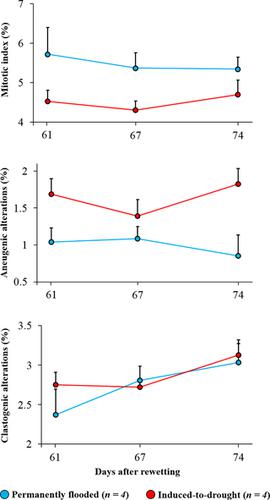PLOS ONE ( IF 3.7 ) Pub Date : 2020-04-02 , DOI: 10.1371/journal.pone.0231082 José R Paranaíba 1 , Gabrielle Quadra 1 , Iollanda I P Josué 2 , Rafael M Almeida 3 , Raquel Mendonça 1 , Simone Jaqueline Cardoso 1 , Júlio Silva 4, 5 , Sarian Kosten 6 , José Marcello Campos 7 , Joseane Almeida 4 , Rafael Lethournon Araújo 7 , Fábio Roland 1 , Nathan Barros 1

|
Increased periods of prolonged droughts followed by severe precipitation events are expected throughout South America due to climate change. Freshwater sediments are especially sensitive to these changing climate conditions. The increased oscillation of water levels in aquatic ecosystems causes enhanced cycles of sediment drying and rewetting. Here we experimentally evaluate the effects of induced drought followed by a rewetting event on the release of carbon dioxide (CO2), methane (CH4), nutrients (nitrogen and phosphorus), and trace elements (iron, manganese, and zinc) from the sediment of a tropical reservoir in southeastern Brazil. Furthermore, we used bulb onions (Allium cepa) to assess the potential cytogenotoxicity of the water overlying sediments after rewetting. We found peaks in CO2 and CH4 emissions when sediments first transitioned from wet to dry, with fluxes declining as sediments dried out. CO2 emissions peaked again upon rewetting, whereas CH4 emissions remained unaltered. Our experiment also revealed average increases by up to a factor of ~5000 in the release rates of nutrients and trace elements in water overlying sediments after rewetting. These increased release rates of potentially toxic compounds likely explain the lower replication of Allium cepa cells (up to 22% reduction) exposed to water overlying sediments after rewetting. Our findings suggest that increased events of drought followed by rewetting may lead to a range of changes in freshwater ecosystems, including nutrient enrichment, increased toxicity following resuspension of contaminants, and higher emission of greenhouse gases to the atmosphere.
中文翻译:

沉积物的干湿循环增加了温室气体的排放,养分和微量元素的释放,并促进了水的细胞遗传毒性。
由于气候变化,预计整个南美地区干旱持续时间延长,随后出现严重降水事件。淡水沉积物对这些不断变化的气候条件特别敏感。水生生态系统中水位振荡的增加导致沉积物干燥和再湿润的周期增加。在这里,我们通过实验评估诱导干旱和再润湿事件对土壤中二氧化碳(CO 2),甲烷(CH 4),养分(氮和磷)和微量元素(铁,锰和锌)释放的影响巴西东南部一个热带水库的沉积物。此外,我们使用鳞茎洋葱(葱属洋葱),以评估重新润湿后覆水沉积物的潜在细胞遗传毒性。我们发现,当沉积物首先从湿态转变为干燥态时,CO 2和CH 4排放量达到峰值,并且随着沉积物变干,通量下降。重新润湿后,CO 2排放再次达到峰值,而CH 4排放保持不变。我们的实验还显示,重新润湿后,沉积物上覆水中的养分和微量元素的释放速率平均平均增加高达〜5000倍。这些潜在有毒化合物的释放速率增加,可能解释了葱属洋葱的复制率较低重新润湿后,细胞(最多减少22%)暴露于上层沉积物中。我们的研究结果表明,干旱事件增加后再润湿可能导致淡水生态系统发生一系列变化,包括营养物质富集,污染物重悬后毒性增加以及向大气中温室气体排放量增加。



























 京公网安备 11010802027423号
京公网安备 11010802027423号